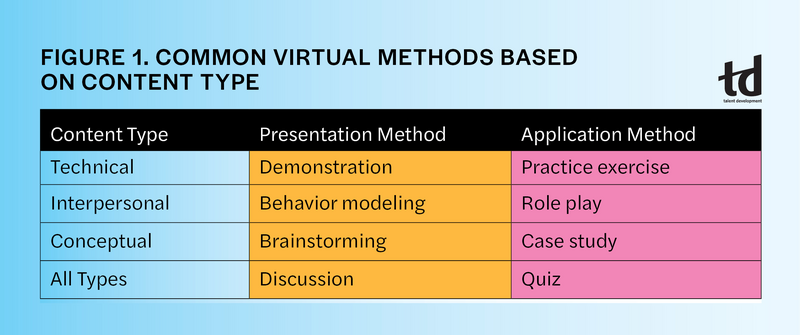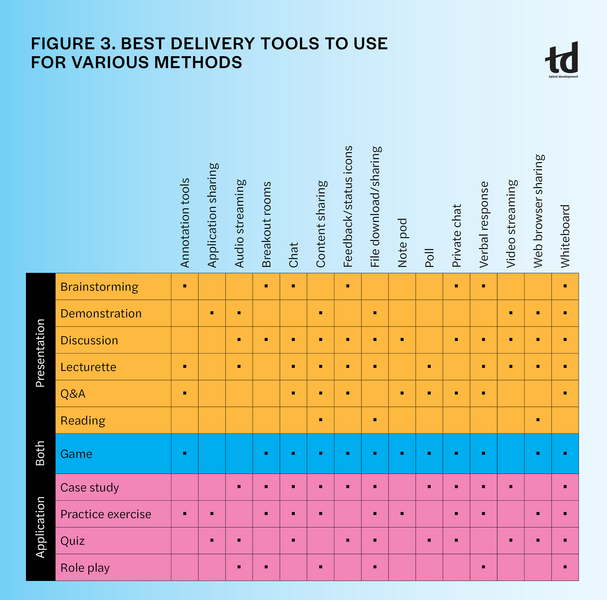TD Magazine Article
Making the Switch
This six-step audit process will help you convert in-person training to a virtual course.
Mon Jun 01 2020

Beware of creating a webinar when convert-ing an instructor-led training (ILT) program to the virtual classroom. Oftentimes talent development professionals make that mistake because of an innocent assumption: We can simply deliver the instructor-led content in the exact same way in the virtual classroom.
Some instructional designers spend hours upon hours making sure an ILT course's key learning points are all addressed in the time allocated for the virtual classroom; however, they put little to no thought into how the course will translate to learners seated at their computers. The end result is extremely presentation-heavy and unengaging—something that looks more like a webinar than a virtual classroom course.
A webinar is primarily used to present or share information, and most of the time, the communication flows one way—from the presenter to the attendees. In contrast, a virtual classroom course allows for two-way communication between the facilitator and the learners and includes plenty of opportunities for learners to practice the skills and knowledge the facilitator presents to them. In addition, participants receive feedback after each application exercise or activity, so they know what they've done well and how they can improve.
With a goal of creating interactive, performance-based virtual classroom training, the instructional design team at Langevin Learning Services worked together to develop a conversion process that would ensure our virtual classroom courses cover the original ILT content; are visually appealing, interactive, and engaging to participants; and include application and practice methods conducive to the virtual environment.
Central to the conversion process is a course audit—a method that ensures the result of a conversion is an effective virtual classroom course aligned with the objectives and content of the ILT course.
To complete the audit, we use a worksheet that helps guide the process and enables us to document the findings. The audit takes six steps.
Step 1: Identify the ILT course's tasks and subtasks
The best place to start the audit is to refer to the ILT course's lesson plan or outline to pinpoint the tasks and subtasks. At a high level, think of them as the whats and how-tos.
A task is defined as what someone does on the job. For example, if grocery store clerks are responsible for processing a grocery order, that is what they do. A task is a collection of subtasks, and each subtask is a logical grouping of five to nine how-to steps. In our example of processing a grocery order, the subtasks are greet customer, process payment, and bag groceries.
When identifying the tasks within the ILT lesson plan, look at the course objectives. Objectives are usually written as verbs followed by nouns such as operate a forklift or plan a project. The tasks and objectives may not be identical, but you should use similar wording in both. Likewise, you should write subtasks in the same verb-noun format.
Step 2: Identify the presentation and application methods
Presentation and application are two crucial components of a performance-based training program, regardless of the strategy. Instructors use presentation methods to deliver the content, and application methods enable learners to practice what they've learned. The methods are fairly easy to identify in an ILT lesson plan by answering two questions:
How is the content being delivered?
How are learners practicing?
For instance, when training grocery store clerks on how to greet customers, an instructor may deliver the content using a discussion method: As a group, participants discuss the correct format, tone of voice, and facial expressions required to ensure customers feel welcome from the moment they step up to the register. Then, when it's time to practice what they discussed, participants take turns role-playing how to greet customers correctly.
Ideally, the ILT lesson plan includes both a presentation and application method for each subtask. However, if you notice a subtask without either method, view it as an opportunity to design something new and unique for the virtual classroom.

Step 3: Document supplemental materials
Add to the course audit worksheet any documents or files that contain relevant content pertaining to a subtask. If, for example, the ILT participants receive a job aid when learning how to greet customers, write that down. It's important for you to note that the job aid already exists so you can potentially repurpose it for the virtual classroom course.
It's also necessary to validate whether supplemental materials such as videos, audio clips, or games are compatible with the virtual classroom platform you'll be using to deliver the training (for example, if a video is saved in a .flv format, ensure the virtual platform can read that type of file).
Step 4: Determine how long it takes to deliver the subtasks
A common misconception about converting ILT to the virtual classroom is that instructors can deliver the course content in less time in the virtual classroom. Although this may be the case for some activities, other exercises may take more time to deliver effectively in a virtual environment.
Consider a role-play exercise in the traditional classroom. It is easy to set up because participants can quickly group themselves by moving their chairs. But in a virtual course, setting up a role play takes longer because the facilitator will need to provide instructions on such factors as what participants can expect when moving to a breakout room and how the audio will work.
Calculating how long it takes to deliver a subtask in the traditional classroom aids in determining how much time should be allocated in the virtual classroom and whether any time-consuming chunks of content may require more effort to convert.
Once you've completed steps 1–4, it's time to make design decisions that will determine the content delivery methods for the virtual classroom.
Step 5: Select the presentation and application methods
The primary goal in converting an ILT course to the virtual classroom is to align the virtual training as closely as possible to the in-person training. Thus, you must figure out whether you can repurpose any ILT methods. To help you decide, think about how the method will be implemented in the virtual classroom.
How long will it take to deliver the method in the virtual classroom?
Is there a way to make it interactive?
Will the tools available in the virtual platform enable the instructor to effectively deliver the method?
Can you repurpose the speaking points, as written, from the ILT content?
If you can envision how to successfully implement the ILT method in the virtual classroom, then you can repurpose it. However, if you decide that it won't work in a virtual environment, you'll need to come up with an alternative. For instance, if time constraints make using a discussion unwieldy, choose a method that requires less time to deliver in a virtual classroom. Consider using a graphic association lecturette or assigning some reading for participants to do as intersession work. Of importance is choosing a variety of methods to ensure the course is an engaging and interactive experience for learners.
Notice in the sample course audit worksheet (Figure 2) the difference in methods for the task of processing a grocery order. The presentation method for the third subtask, bag groceries, is a lecture in the ILT version, but we chose a discussion for the virtual version of the course. Why? Because lectures can be monotonous and boring. They can be a risky choice for a virtual course, because learners can easily check out and do other things.
Given that, using a discussion over a lecture is a better choice because it involves the learners, engages them, and enables everyone to contribute. In addition, there are different options when it comes to how a discussion unfolds in the virtual classroom—it could take place as one large group or in several smaller groups using breakout rooms.

Step 6: Select a delivery tool
After you've chosen a method, determine which of your available virtual platform tools is best suited to implement it. When choosing a tool, consider how long it will take to deliver the method using that tool. If you are limited to five minutes for a discussion, it may be better to have participants discuss the content using the chat function instead of having each participant respond verbally.
The exciting part is that you have myriad options—this is where your creativity comes into play. Once you know what the platform is capable of, you can start choosing the tools and features that will bring the content to life. Remember: Aim for variety. That ensures you are maximizing participant engagement by having them use different tools throughout the course.

For those who are new to the conversion process, selecting the right tool can seem a bit overwhelming at first. Which tools work best with the methods you've chosen? What should you do if there are constraints regarding the tools available within the platform?
We've taken some of the guesswork out of that by creating Figure 3. Listed vertically along the left side of the chart are the most common presentation and application methods, and the more common tools (across most virtual classroom platforms) are along the top. The dots represent which tools work best for each method.
Every method has at least three different tools that instructors can use to implement it. For example, if the course entails using a demonstration as a presentation method, seven options are available; if a role play is the chosen application method, consider using one of the six listed tool options.
Set yourself up for success with all your conversion projects by taking the time to learn what tools and functionalities are available in your organization's virtual platform. Doing so will help you choose the most appropriate tools to make your methods come alive and help you create an engaging virtual learning experience for your participants. A bonus is that you may convince naysayers that the virtual classroom can be just as interactive as ILT, if not more so.
A conversion road map
In the end, as seen in the Sample Course Audit Worksheet, you will have an at-a-glance road map to developing an interactive, performance-based virtual classroom course. Once you have completed this audit, converting the ILT content to the virtual classroom will seem effortless.
